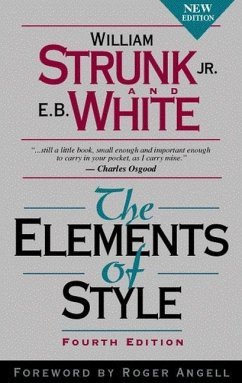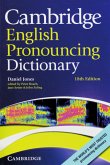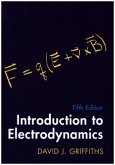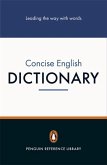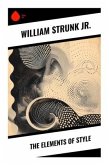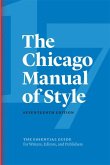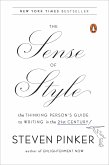- Buch mit Kunststoff-Einband
"You know the authors' names. You recognize the title. You've probably used this book yourself. This is The Elements of Style, the classic style manual, now in a fourth edition. A new Foreword by Roger Angell reminds readers that the advice of Strunk & White is as valuable today as when it was first offered.This book's unique tone, wit and charm have conveyed the principles of English style to millions of readers. Use the fourth edition of "the little book" to make a big impact with writing. "
Andere Kunden interessierten sich auch für
![Cambridge English Pronouncing Dictionary Cambridge English Pronouncing Dictionary]() Daniel JonesCambridge English Pronouncing Dictionary54,00 €
Daniel JonesCambridge English Pronouncing Dictionary54,00 €![Introduction to Electrodynamics Introduction to Electrodynamics]() David J. GriffithsIntroduction to Electrodynamics76,99 €
David J. GriffithsIntroduction to Electrodynamics76,99 €![The Elements of Style - Illustrated The Elements of Style - Illustrated]() Strunk, William, Jr.The Elements of Style - Illustrated15,99 €
Strunk, William, Jr.The Elements of Style - Illustrated15,99 €![Penguin Concise English Dictionary Penguin Concise English Dictionary]() Penguin Concise English Dictionary21,99 €
Penguin Concise English Dictionary21,99 €![The Elements of Style The Elements of Style]() Strunk, William, Jr.The Elements of Style9,50 €
Strunk, William, Jr.The Elements of Style9,50 €![The Chicago Manual of Style The Chicago Manual of Style]() The University The UniversityThe Chicago Manual of Style51,99 €
The University The UniversityThe Chicago Manual of Style51,99 €![The Sense of Style The Sense of Style]() Steven PinkerThe Sense of Style10,99 €
Steven PinkerThe Sense of Style10,99 €-
-
-
-
-
-
-
"You know the authors' names. You recognize the title. You've probably used this book yourself. This is The Elements of Style, the classic style manual, now in a fourth edition. A new Foreword by Roger Angell reminds readers that the advice of Strunk & White is as valuable today as when it was first offered.This book's unique tone, wit and charm have conveyed the principles of English style to millions of readers. Use the fourth edition of "the little book" to make a big impact with writing. "
Hinweis: Dieser Artikel kann nur an eine deutsche Lieferadresse ausgeliefert werden.
Hinweis: Dieser Artikel kann nur an eine deutsche Lieferadresse ausgeliefert werden.
Produktdetails
- Produktdetails
- Verlag: B&T / PEV
- 4. Aufl.
- Seitenzahl: 105
- Erscheinungstermin: 29. Mai 2024
- Englisch
- Abmessung: 131mm x 207mm x 15mm
- Gewicht: 278g
- ISBN-13: 9780205313426
- ISBN-10: 0205313426
- Artikelnr.: 09810246
- Herstellerkennzeichnung
- Pearson
- St.-Martin-Straße 82
- 81541 München
- salesde@pearson.com
- +4989541960460
- Verlag: B&T / PEV
- 4. Aufl.
- Seitenzahl: 105
- Erscheinungstermin: 29. Mai 2024
- Englisch
- Abmessung: 131mm x 207mm x 15mm
- Gewicht: 278g
- ISBN-13: 9780205313426
- ISBN-10: 0205313426
- Artikelnr.: 09810246
- Herstellerkennzeichnung
- Pearson
- St.-Martin-Straße 82
- 81541 München
- salesde@pearson.com
- +4989541960460
William Strunk, Jr. first used his own book, The Elements of Style, in 1919 for his English 8 course at Cornell University. The book was published in 1935 by Oliver Strunk. E. B. White was a student in Professor Strunk's class at Cornell, and used "the little book" for himself. Commissioned by Macmillan to revise Strunk's book, White edited the 1959 and 1972 editions of The Elements of Style.
FOREWORD.
INTRODUCTION.
I.ELEMENTARY RULES OF USAGE.
1.Form the Possessive Singular of Nouns by Adding 's.
2.In a Series of Three or More Terms with a Single Conjunction, Use a
Comma after Each Term except the Last.
3.Enclose Parenthetic Expressions between Commas.
4.Place a Comma before a Conjunction Introducing an Independent Clause.
5.Do Not Join Independent Clauses with a Comma.
6.Do Not Break Sentences in Two.
7.Use a Colon after an Independent Clause to Introduce a List of
Particulars, an Appositive, an Amplification, or an Illustrative Question.
8.Use a Dash to Set Off an Abrupt Break or Interruption and to Announce a
Long Appositive or Summary.
9.The Number of the Subject Determines the Number of the Verb.
10.Use the Proper Case of Pronoun.
11.A Participial Phrase at the Beginning of the Sentence Must Refer to the
Grammatical Subject.
II.ELEMENTARY PRINCIPLES OF COMPOSITION.
12.Choose a Suitable Sesign and Hold to It.
13.Make the Paragraph the unit of Composition.
14.Use the Active Voice.
15.Put Statements in Positive Form.
16.Use Definite, Specific, Concrete Language.
17.Omit Needless Words.
18.Avoid a Succession of Loose Sentences.
19.Express Coordinate Ideas in Similar Form.
20.Keep Related Words Together.
21.In Summaries, Keep to One Tense.
22.Place the Emphatic Words of a Sentence at the End.
III.A FEW MATTERS OF FORM.
IV.WORDS AND EXPRESSIONS COMMONLY MISUSED.
V.AN APPROACH TO STYLE (WITH A LIST OF REMINDERS).
1.Place Yourself in the Background.
2.Write in a Way That Comes Naturally.
3.Work From a Suitable Style.
4.Write with Nouns and Verbs.
5.Revise and Rewrite.
6.Do Not Overwrite.
7.Do Not Overstate.
8.Avoid the Use of Qualifiers.
9.Do Not Affect a Breezy Manner.
10.Use Orthodox Spelling.
11.Do Not Explain Too Much.
12.Do Not Construct Awkward Adverbs.
13.Make Sure the Reader Knows Who is Speaking.
14.Avoid Fancy Words.
15.Do Not Use Dialect Unless Your Ear Is Good.
16.Be Clear.
17.Do Not Inject Opinion.
18.Use Figures of Speech Sparingly.
19.Do Not Take Shortcuts at the Cost of Clarity.
20.Avoid Foreign Languages.
21.Prefer the Standard to the Offbeat.
Afterword.
Glossary.
INTRODUCTION.
I.ELEMENTARY RULES OF USAGE.
1.Form the Possessive Singular of Nouns by Adding 's.
2.In a Series of Three or More Terms with a Single Conjunction, Use a
Comma after Each Term except the Last.
3.Enclose Parenthetic Expressions between Commas.
4.Place a Comma before a Conjunction Introducing an Independent Clause.
5.Do Not Join Independent Clauses with a Comma.
6.Do Not Break Sentences in Two.
7.Use a Colon after an Independent Clause to Introduce a List of
Particulars, an Appositive, an Amplification, or an Illustrative Question.
8.Use a Dash to Set Off an Abrupt Break or Interruption and to Announce a
Long Appositive or Summary.
9.The Number of the Subject Determines the Number of the Verb.
10.Use the Proper Case of Pronoun.
11.A Participial Phrase at the Beginning of the Sentence Must Refer to the
Grammatical Subject.
II.ELEMENTARY PRINCIPLES OF COMPOSITION.
12.Choose a Suitable Sesign and Hold to It.
13.Make the Paragraph the unit of Composition.
14.Use the Active Voice.
15.Put Statements in Positive Form.
16.Use Definite, Specific, Concrete Language.
17.Omit Needless Words.
18.Avoid a Succession of Loose Sentences.
19.Express Coordinate Ideas in Similar Form.
20.Keep Related Words Together.
21.In Summaries, Keep to One Tense.
22.Place the Emphatic Words of a Sentence at the End.
III.A FEW MATTERS OF FORM.
IV.WORDS AND EXPRESSIONS COMMONLY MISUSED.
V.AN APPROACH TO STYLE (WITH A LIST OF REMINDERS).
1.Place Yourself in the Background.
2.Write in a Way That Comes Naturally.
3.Work From a Suitable Style.
4.Write with Nouns and Verbs.
5.Revise and Rewrite.
6.Do Not Overwrite.
7.Do Not Overstate.
8.Avoid the Use of Qualifiers.
9.Do Not Affect a Breezy Manner.
10.Use Orthodox Spelling.
11.Do Not Explain Too Much.
12.Do Not Construct Awkward Adverbs.
13.Make Sure the Reader Knows Who is Speaking.
14.Avoid Fancy Words.
15.Do Not Use Dialect Unless Your Ear Is Good.
16.Be Clear.
17.Do Not Inject Opinion.
18.Use Figures of Speech Sparingly.
19.Do Not Take Shortcuts at the Cost of Clarity.
20.Avoid Foreign Languages.
21.Prefer the Standard to the Offbeat.
Afterword.
Glossary.
FOREWORD.
INTRODUCTION.
I.ELEMENTARY RULES OF USAGE.
1.Form the Possessive Singular of Nouns by Adding 's.
2.In a Series of Three or More Terms with a Single Conjunction, Use a
Comma after Each Term except the Last.
3.Enclose Parenthetic Expressions between Commas.
4.Place a Comma before a Conjunction Introducing an Independent Clause.
5.Do Not Join Independent Clauses with a Comma.
6.Do Not Break Sentences in Two.
7.Use a Colon after an Independent Clause to Introduce a List of
Particulars, an Appositive, an Amplification, or an Illustrative Question.
8.Use a Dash to Set Off an Abrupt Break or Interruption and to Announce a
Long Appositive or Summary.
9.The Number of the Subject Determines the Number of the Verb.
10.Use the Proper Case of Pronoun.
11.A Participial Phrase at the Beginning of the Sentence Must Refer to the
Grammatical Subject.
II.ELEMENTARY PRINCIPLES OF COMPOSITION.
12.Choose a Suitable Sesign and Hold to It.
13.Make the Paragraph the unit of Composition.
14.Use the Active Voice.
15.Put Statements in Positive Form.
16.Use Definite, Specific, Concrete Language.
17.Omit Needless Words.
18.Avoid a Succession of Loose Sentences.
19.Express Coordinate Ideas in Similar Form.
20.Keep Related Words Together.
21.In Summaries, Keep to One Tense.
22.Place the Emphatic Words of a Sentence at the End.
III.A FEW MATTERS OF FORM.
IV.WORDS AND EXPRESSIONS COMMONLY MISUSED.
V.AN APPROACH TO STYLE (WITH A LIST OF REMINDERS).
1.Place Yourself in the Background.
2.Write in a Way That Comes Naturally.
3.Work From a Suitable Style.
4.Write with Nouns and Verbs.
5.Revise and Rewrite.
6.Do Not Overwrite.
7.Do Not Overstate.
8.Avoid the Use of Qualifiers.
9.Do Not Affect a Breezy Manner.
10.Use Orthodox Spelling.
11.Do Not Explain Too Much.
12.Do Not Construct Awkward Adverbs.
13.Make Sure the Reader Knows Who is Speaking.
14.Avoid Fancy Words.
15.Do Not Use Dialect Unless Your Ear Is Good.
16.Be Clear.
17.Do Not Inject Opinion.
18.Use Figures of Speech Sparingly.
19.Do Not Take Shortcuts at the Cost of Clarity.
20.Avoid Foreign Languages.
21.Prefer the Standard to the Offbeat.
Afterword.
Glossary.
INTRODUCTION.
I.ELEMENTARY RULES OF USAGE.
1.Form the Possessive Singular of Nouns by Adding 's.
2.In a Series of Three or More Terms with a Single Conjunction, Use a
Comma after Each Term except the Last.
3.Enclose Parenthetic Expressions between Commas.
4.Place a Comma before a Conjunction Introducing an Independent Clause.
5.Do Not Join Independent Clauses with a Comma.
6.Do Not Break Sentences in Two.
7.Use a Colon after an Independent Clause to Introduce a List of
Particulars, an Appositive, an Amplification, or an Illustrative Question.
8.Use a Dash to Set Off an Abrupt Break or Interruption and to Announce a
Long Appositive or Summary.
9.The Number of the Subject Determines the Number of the Verb.
10.Use the Proper Case of Pronoun.
11.A Participial Phrase at the Beginning of the Sentence Must Refer to the
Grammatical Subject.
II.ELEMENTARY PRINCIPLES OF COMPOSITION.
12.Choose a Suitable Sesign and Hold to It.
13.Make the Paragraph the unit of Composition.
14.Use the Active Voice.
15.Put Statements in Positive Form.
16.Use Definite, Specific, Concrete Language.
17.Omit Needless Words.
18.Avoid a Succession of Loose Sentences.
19.Express Coordinate Ideas in Similar Form.
20.Keep Related Words Together.
21.In Summaries, Keep to One Tense.
22.Place the Emphatic Words of a Sentence at the End.
III.A FEW MATTERS OF FORM.
IV.WORDS AND EXPRESSIONS COMMONLY MISUSED.
V.AN APPROACH TO STYLE (WITH A LIST OF REMINDERS).
1.Place Yourself in the Background.
2.Write in a Way That Comes Naturally.
3.Work From a Suitable Style.
4.Write with Nouns and Verbs.
5.Revise and Rewrite.
6.Do Not Overwrite.
7.Do Not Overstate.
8.Avoid the Use of Qualifiers.
9.Do Not Affect a Breezy Manner.
10.Use Orthodox Spelling.
11.Do Not Explain Too Much.
12.Do Not Construct Awkward Adverbs.
13.Make Sure the Reader Knows Who is Speaking.
14.Avoid Fancy Words.
15.Do Not Use Dialect Unless Your Ear Is Good.
16.Be Clear.
17.Do Not Inject Opinion.
18.Use Figures of Speech Sparingly.
19.Do Not Take Shortcuts at the Cost of Clarity.
20.Avoid Foreign Languages.
21.Prefer the Standard to the Offbeat.
Afterword.
Glossary.

